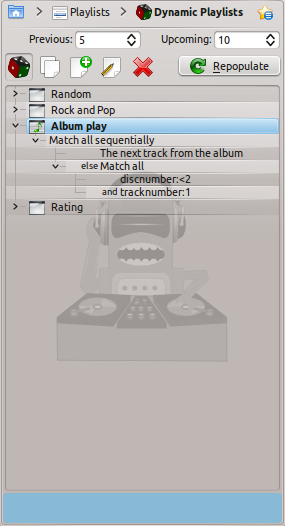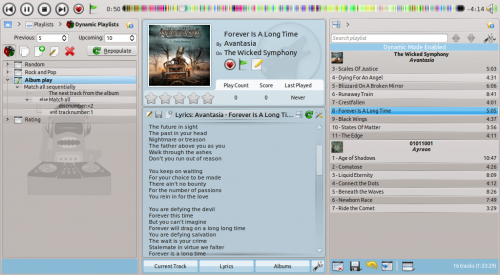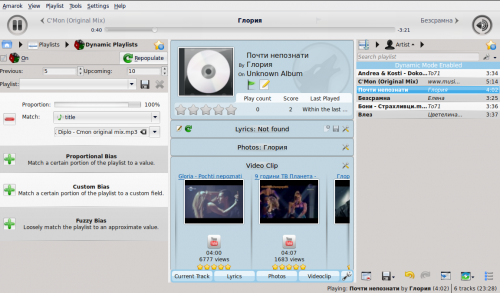Amarok/Manual/Playlist/DynamicPlaylists/cs: Difference between revisions
No edit summary |
Created page with "Každý dynamický seznam skladeb je postaven na upřednostňování. Upřednostňování určuje zvláštní omezení chování dynamického seznamu skladeb a nové položky,..." |
||
| Line 23: | Line 23: | ||
==== Vymezení dynamických seznamů skladeb ==== | ==== Vymezení dynamických seznamů skladeb ==== | ||
Každý dynamický seznam skladeb je postaven na upřednostňování. Upřednostňování určuje zvláštní omezení chování dynamického seznamu skladeb a nové položky, které se mají přidat do seznamu skladeb jsou vybírány náhodně ze seznamu všech písní, které odpovídají tomuto zkreslení výběru. Upřednostňování mohou být buď jednoduchá (např. upřednostňování při ''hledání'') nebo skupiny jiných upřednostňování (např. upřednostňování ''porovnávající vše''). Jsou zahrnuty některé příklady seznamů skladeb. Nový seznam skladeb určíte pomocí tlačítka {{Icon|document-new}}. | |||
To change the name of a playlist, either use the {{Icon|document-properties}} button or right click on it and select <menuchoice>Rename playlist</menuchoice>. A bias can be edited with the same button or by right-clicking and selecting <menuchoice>Edit bias</menuchoice>, and for biases which have sub-biases, a new sub-bias can be added by right clicking and selecting <menuchoice>Add new bias</menuchoice>. | To change the name of a playlist, either use the {{Icon|document-properties}} button or right click on it and select <menuchoice>Rename playlist</menuchoice>. A bias can be edited with the same button or by right-clicking and selecting <menuchoice>Edit bias</menuchoice>, and for biases which have sub-biases, a new sub-bias can be added by right clicking and selecting <menuchoice>Add new bias</menuchoice>. | ||
Revision as of 15:47, 1 September 2013
Dynamické seznamy skladeb
Některé přehrávače jsou navrženy tak, že nahrávají celou hudební sbírku do jednoho seznamu skladeb. Potom ji přehrávají v náhodném pořadí, nebo prohledanou/roztříděnou, a pak seřazenou. U větších sbírek není tento způsob správy seznamu skladeb účinný. Dynamické seznamy skladeb Amaroku jsou lepší cestou, jak prozkoumat vaši hudbu.
Na dynamické seznamy skladeb dosáhnete přes v poli s hudebními zdroji.

Jak dynamický seznam skladeb pracuje
Dynamický seznam skladeb je seznam, který roste s tím, jak posloucháte hudbu. Bude uchovávat určitý počet písní před nyní přehrávanou píseň a bude uklízet seznam skladeb odstraňováním starých písní. Písně, které budou přidány do přední části seznamu skladeb, jsou určeny nyní vybraným dynamickým seznamem skladeb.
Používání dynamického seznamu skladeb
Pro povolení dynamických seznamů skladeb, klepněte na tlačítko ![]() v poli s dynamickými seznamy skladeb. Nahoře pole se seznamem skladeb se zobrazí pruh oznamující, že je to povoleno. Vyberte, který dynamický seznam skladeb se má použít, v seznamu voleb, tím že na něj poklepáte. nyní vybraný dynamický seznam skladeb je proveden tučným řezem písma.
v poli s dynamickými seznamy skladeb. Nahoře pole se seznamem skladeb se zobrazí pruh oznamující, že je to povoleno. Vyberte, který dynamický seznam skladeb se má použít, v seznamu voleb, tím že na něj poklepáte. nyní vybraný dynamický seznam skladeb je proveden tučným řezem písma.
Můžete upravit počet v seznamu skladeb zobrazených písní přehrávaných před a po nyní hrající písni polí a . Můžete zabránit tomu, aby se stejná skladba objevila v nynějším seznamu skladeb více než jednou pomocí tlačítka ![]() . Tlačítko vám umožní vytvořit novou sadu skladeb. To lze použít společně s nastavením na vytvoření pevných seznamů skladeb pro jejich vyvedení do souboru.
. Tlačítko vám umožní vytvořit novou sadu skladeb. To lze použít společně s nastavením na vytvoření pevných seznamů skladeb pro jejich vyvedení do souboru.
Vymezení dynamických seznamů skladeb
Každý dynamický seznam skladeb je postaven na upřednostňování. Upřednostňování určuje zvláštní omezení chování dynamického seznamu skladeb a nové položky, které se mají přidat do seznamu skladeb jsou vybírány náhodně ze seznamu všech písní, které odpovídají tomuto zkreslení výběru. Upřednostňování mohou být buď jednoduchá (např. upřednostňování při hledání) nebo skupiny jiných upřednostňování (např. upřednostňování porovnávající vše). Jsou zahrnuty některé příklady seznamů skladeb. Nový seznam skladeb určíte pomocí tlačítka ![]() .
.
To change the name of a playlist, either use the ![]() button or right click on it and select . A bias can be edited with the same button or by right-clicking and selecting , and for biases which have sub-biases, a new sub-bias can be added by right clicking and selecting .
button or right click on it and select . A bias can be edited with the same button or by right-clicking and selecting , and for biases which have sub-biases, a new sub-bias can be added by right clicking and selecting .
Upřednostňování
Because multiple biases may be defined, Amarok may at times return an empty playlist. This occurs if it is given a set of impossible-to-fulfill conditions. To avoid this and to better understand each available bias, along with any options it takes, please see below:
- Search
- This bias matches tracks found by a given search query. It uses the same search string used in the collection browser. You may also use the Match meta tag bias to match tags in the same way as the collection search editor.
- Random
- This bias matches any track, entirely at random.
- And
- This group bias matches tracks which match all sub-biases.
- Or
- This group bias matches tracks which match any sub-biases.
- Partition
- This group bias matches tracks from the sub-biases in proportion. The edit window for this bias has sliders for each sub-bias to adjust the proportions. For example, with two sub-biases with their proportion sliders set equal, half of the playlist will match one bias and half the other.
- Note: The dynamic playlist is internally working with more tracks than you can see, so after clicking "Repopulate" the list might not contain a 50:50 distribution of songs. However as you continue listening to music you will see that in the end it actually matches.
- If Else
- This group bias matches tracks from the first sub bias unless there are no matching tracks found, in which case it matches tracks from the second sub-bias. See the example Album Play playlist for an example of this in use.
- Match Meta Tag
- This bias matches tracks which meet certain conditions on a tag. The selection interface is the same as the search filter editor in the collection browser. Select a tag type from the drop-down and fill in the constraint. (Hint: You can use a number of these in an And bias.)
- Album Play
- This bias matches tracks related to the previous item in the playlist by album. You can select the details of the bias from the drop-down menu. For example, Track directly follows previous track in album is used in the example Album Play playlist to ensure full albums are played in order.
- Quiz Play
- This bias matches tracks for which the first character of a given tag (title, artist or album) is the same as the last character of the same tag for the previous tag. For example, with artist selected, you could have the following series: Led Zeppelin -> Nine Inch Nails -> Santana, etc.
- EchoNest similar artist
- This bias matches tracks which are similar according to EchoNest, either to the previous track or to any track in the playlist. This allows you to play a set of consistent tracks simply by adding a single track to the playlist and turning on the dynamic playlist, rather than defining all the match rules yourself.
- Last.fm similar
- This bias performs the same function as the EchoNest bias, but uses Last.fm to determine similarity. You can also choose similarity to the previous track or to the previous artist.
- Last.fm weekly top artist
- This bias matches tracks which are on the weekly charts from Last.fm for a given time period.
Dynamický seznam skladeb v používání

Používání dynamického seznamu skladeb
To enable the dynamic playlist you have created simply check the box in the upper-left corner of the pane. To regenerate the entire playlist at any time, click , to the right of .
The default number of items in the playlist is your 5 previous plays plus 10 upcoming items. With the currently playing track, this makes 16 items in the playlist at any given time. The number of tracks can be changed right below the checkbox.
Below that is the dropdown menu for loading saved playlists, the ![]() button to save playlists, and the
button to save playlists, and the ![]() button to delete them.
button to delete them.
Dynamický seznam skladeb v používání

